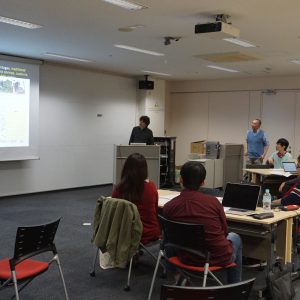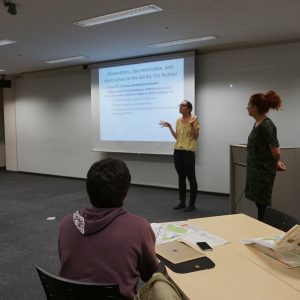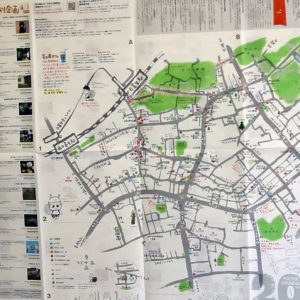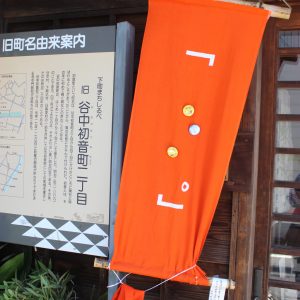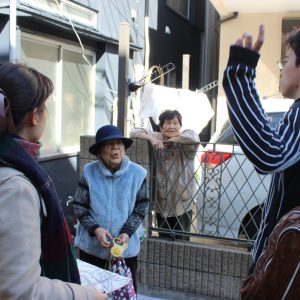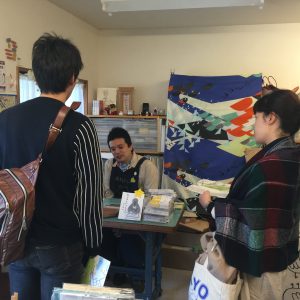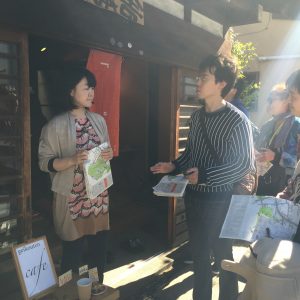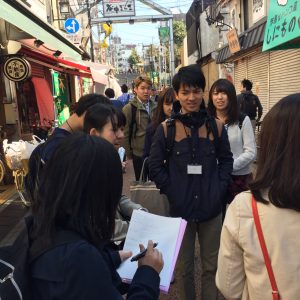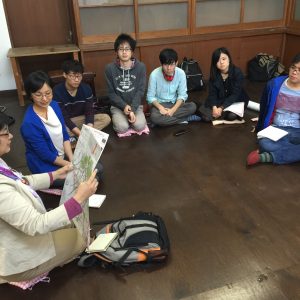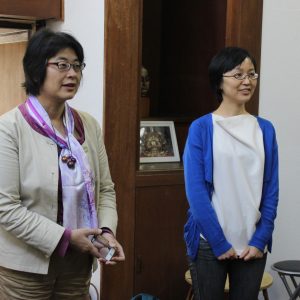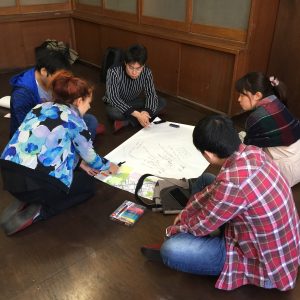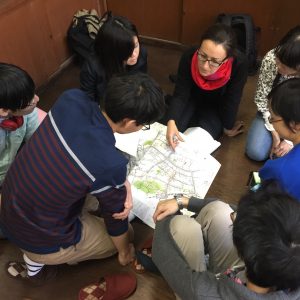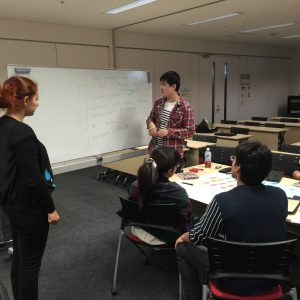
Mapping Yanaka media practices and media ecologies
The workshop aimed to explore ways of diving into and understanding the everyday practices around machizukuri in Yanaka, especially by exploring the role of the Yanaka Art and Design Festival, or Gei-ko-ten, through mapping and interviewing people during the festival. The Gei-ko-ten festival has run consecutively for 23 years, celebrating the community and shedding light on the various skills in arts, design and crafts that exist in the neighborhood.
The intensive workshop was organized for October 23-26, 2015. A multidisciplinary group of graduate students took part in the introductory lectures and conducted fieldwork around Yanaka during the last day of Gei-ko-ten. The students were divided into two teams, with members of the Finnish and Japanese workshop organizers joining them. Each team selected a specific theme to explore and devised a relevant walking route or strategy to explore Yanaka.
Participants observed and documented the community activities in Yanaka and interviewed people taking part in the festival as well as residents of and visitors to the area. The aim was to understand the role of the Gei-ko-ten in Yanaka, and especially its particular role as part of machizukuri activities. In addition, the participants aimed to map and collect material related to the use of digital media and technologies in Yanaka, especially the ways in which the participating shops, practitioners and artists prepare and take part in the festival.
Afterwards, the fieldwork participants had a chance to interview some of the representatives of the Gei-ko-ten organizers and receive feedback for their initial findings. From this media rich material, participants prepared a map of an urban neighborhood as seen through the lens of Gei-ko-ten. The teams also produced presentations on the process and suggested solutions to the challenges and gaps they had identified from their fieldwork.
The workshop provided a better understanding of a particular kind of hybrid community life and activities, and uncovered why and how the neighborhood is taking part in Gei-ko-ten.
The multiple interviews especially shed light on the differing motivations of the people participating, leading also to a multi-faceted understanding of the reason(s) behind the organization of the festival. Participants also highlighted issues around knowledge sharing among stakeholders before and during the festival, and pointed out that based on their findings there is a visible gap between the older and younger generations ― both of whom are exhibiting and participating in the festival. One proposal offered by the participants of the workshop was more effective use of social media.
In general we can conclude that there are some similarities between the activities of self-organized communities in Nordic countries and those of the machizukuri movements in Japan. In both contexts we identified the rise of “thematic associations” in ways that influence the shaping of the urban environment.
企画の背景
フィンランド・アアルト大学より講師を招き、北欧諸国におけるフィールドワーク型ワークショップと日本型まちづくりワークショップとの融合を、メディア実践とメディアエコロジーをキーワードとしておこなう。23年間実施されてきた谷中地区における「芸工展」を対象とし、フィールドワーク(インタビューや現地観察)で得られた情報のさまざまな関係性をメディアと地域コミュニティに着目して「マッピング」という手法によって整理することが特徴的である。
どんなワークショップ?
本ワークショップは3日間のプログラムとなっている。
1日目は、日本におけるまちづくり、特に谷中でのまちづくり活動についての講義、メディア実践・メディアエコロジーについての北欧での取り組みの紹介、さらにはマッピング手法による情報整理についてのレクチャーがおこなわれた。8名の参加学生は4名ずつの2チームに分かれ、取り上げるテーマを「若もの」と「テクノロジー」と決めたのち、明後日のフィールドワークの際の戦略(調査ルート、調査項目など)を議論し決定した。
2日目は、午前中から芸工展が開催されている谷中地区をフィールドワークした。各チームの戦略に沿って谷中地区を歩き、適宜、訪問者や店主、芸工展の主催事務局へのインタビュー調査を実施している。昼食後、谷中地区の歴史的建築物である旧平櫛田中邸にてフィールドワークで得た情報のマッピングを、芸工展に長く関わってきた「たいとう歴史都市研究会」のメンバーと議論しながらおこなった。その成果を大学教室へ持ち帰って整理し、翌日のプレゼンテーションの準備をおこなっている。これらの過程では、各班にフィンランドからの研究者がそれぞれアドバイザーとして加わっている。
3日目はプレゼンテーションと振り返りをおこなった。
プログラム
| 約2週間前~ | 事前準備(参考文献、Web情報の読み込み) | |
|---|---|---|
| 1日目(10.23) | 自己紹介、レクチャー(大学教室) | |
| 2日目(10.25) | フィールドワーク(現地調査、インタビュー調査)(谷中地区) | |
| 3日目(10.26) | プレゼンテーション(大学教室) |
ワークショップの成果
各班は、それぞれ「若もの」と「テクノロジー」をテーマとしてスライドによるプレゼンテーションをおこなった。芸工展への関わり方にはさまざまな形があること、たとえば来街者は芸工展が開催中とは知らずに谷中に訪れているし、地区居住者も年齢や地域への関わり方によって芸工展への関わり方が違うことなどが発見された。メディアの使われ方については、電子的・仮想的メディアよりも物理的・具体的メディアの使用が多いことが発見されている。
ふり返り
今回のワークショップは、フィンランド・アアルト大学の研究者と協同で企画・運営をおこなった。ワークショップに彼らが北欧諸国で実践してきたワークショップ手法を取り入れるような工夫をおこなった。とはいえ、フィールドワークの方法やマッピングという情報整理の手法は日本におけるまちづくりワークショップで広く実践されている方法と大きな相違点がなく、運営について特段の問題は生じなかった。
ワークショップに参加した学生に建築都市系で学んだことがある学生は1人しかおらず、地区の空間やそこで発生するコミュニティの捉え方を学ぶことができたと思う。インタビュー調査や現地調査で得られることと、複数人KJ法的に得られた情報を整理していくワークショップの好例になったと言える。
また、本ワークショップの研究的目的のひとつでもある北欧諸国とのコミュニティの比較については、コミュニティ活動についての類似性を発見することができた。特にテーマ型コミュニティの存在がキーコンテンツとなっており、ワークショップを実践した学生も、スタッフも強く認識できた。
| アイテム | 模造紙、付箋紙、マーカー、地図(芸工展マップ)、ノートパソコン、スマートフォン(フィールドワーク時) |
|
|---|---|---|
| 開催日時 | 2015.10.23(金)16:00 - 19:00 |
|
| 場所 | 東京大学工学部2号館9階92B教室 |
|
| 参加者・人数 | 8名 |
|
| 講師/ファシリテーター | スタッフ: 協同企画・運営: 地域協力講師: |
原稿執筆:真鍋陸太郎


